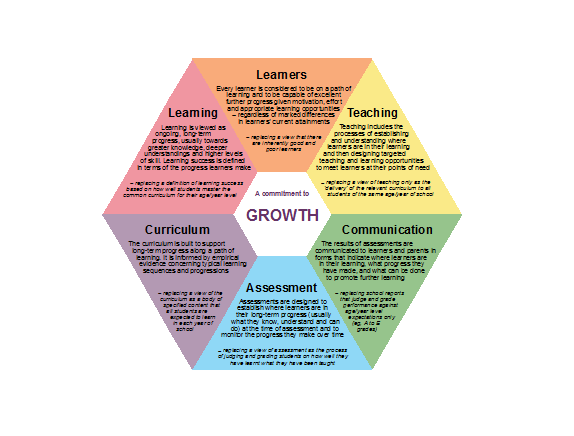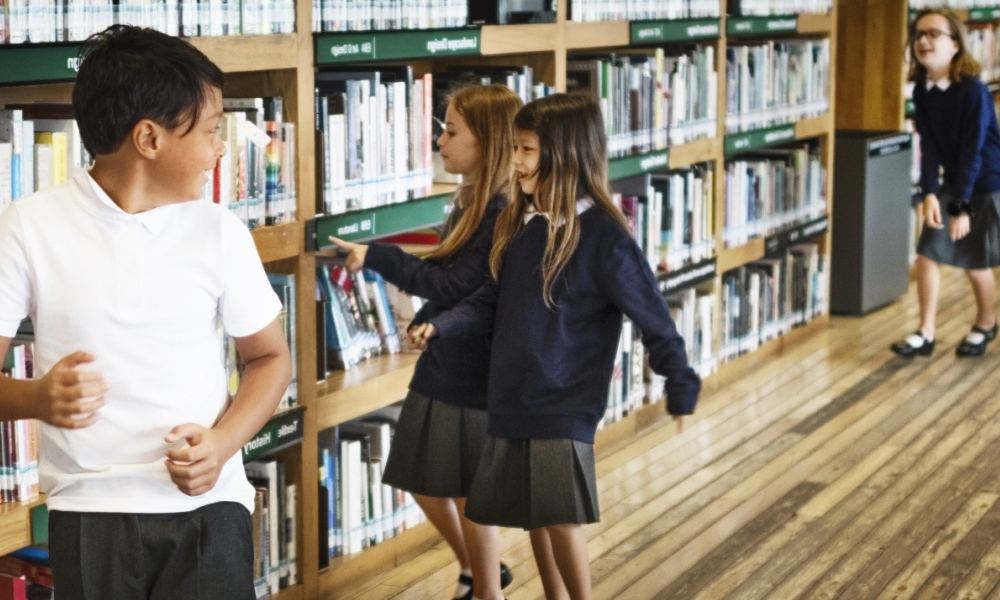A commitment to growth
A commitment to growth is a commitment to every student's successful learning.
Students begin each school year at very different stages in their learning and development, meaning that it is unrealistic to set the same learning expectations for all students or to expect all students to be at the same point in their learning at the same time. Nevertheless, every student should be expected to make excellent progress in their learning – regardless of their starting point.
A commitment to every student's progress, or growth, invites particular ways of thinking about learning, learners, teaching, the curriculum, assessment and the reporting of student achievement, as summarised in the following diagram:
Click here to view an enlarged version of the diagram below.

Figure 1. An alternative way to think about learning, learners, teaching, the curriculum, assessment and the reporting of student achievement.
Learning
What it means to learn successfully at school has commonly been defined in terms of the curriculum. In other words, students who demonstrate most of the curriculum for their year level have been considered to have learnt successfully; those who do not have been considered to have learnt less successfully.
This conclusion might be reasonable if all students began the school year at the same point in their learning, but in general they do not. Students begin each school year at widely dispersed levels of achievement. When all students are then judged and graded against the same year-level expectations, some students are advantaged and others are disadvantaged by their very different starting points.
A more useful way to define what it means to learn successfully is by reference to the progress students make in their learning. From this perspective, two students who begin at different starting points but make equal progress might be considered to have learnt equally well, despite their different end points.
This definition of learning as progress requires a change in frame of reference – from a defined body of common curriculum content to a well-articulated path of long-term learning progress.
Learners
A commitment to growth also invites a different way of thinking about learners.
A conventional belief is that students differ markedly in their capacity to learn. Some students are considered more ‘intelligent' than others and thus more capable of successful learning. The fact that some students perform better than others on tests of the school curriculum is often interpreted as evidence of inherent differences in learning ability.
A more helpful view sees every student as capable of learning if they are motivated and engaged, prepared to make an effort, and provided with well-targeted learning opportunities. This view is supported by current understandings of learning and brain plasticity. Today we are much less inclined to place limits on what individuals can learn given time and the right conditions. This view recognises that students of the same age will be at different points in their learning and may be progressing at different rates, but sees every learner as capable of making good learning progress.
Teaching
A common view of teaching equates it with the ‘delivery' of a pre-specified syllabus or curriculum. Under this view, the role of teachers is to teach what students are expected to learn, including by making the delivered content engaging, relevant and interesting. The starting point is the defined body of content that all students are to learn. The role of teachers is to deliver this content and the role of students is to learn it.
This view of teaching may be appropriate for some kinds of learning and when all students are at similar starting points in their learning. However, when students are widely dispersed in their levels of attainment, effective teaching depends first on establishing and understanding where individuals are in their learning and second on providing well-targeted teaching and learning opportunities to meet learners at their points of need. The differentiation of teaching in this way is usually more difficult than delivering the same content to all students, but is essential in ensuring that every student is challenged appropriately and makes good progress in their learning.
Curriculum
The school curriculum is commonly conceptualised as a body of content to be taught and learnt in each year of school. The curriculum specifies the topics to be covered and the knowledge, skills and understandings that all students in that year of school are to be taught and are expected to learn. All students are assessed and graded on how much of the year-level curriculum they have mastered. Each new year is a fresh start, with a new body of content to be taught, learned and assessed. It is sometimes observed that this way of organising the school curriculum has much in common with an assembly line.
An alternative is to think in terms of a continuous path of progress within an area of learning and to recognise that, in any given year of school, students are widely spread out along this path. The curriculum is built to support students' ongoing progress, regardless of their age or year level. Importantly, the construction of a map of long-term progress in an area of learning depends on empirical evidence about the nature of learning within that area, including the role of prerequisites, typical sequences and learning progressions. In this sense, the curriculum reflects much more than somebody's belief about what should be taught to all students in a given year of school.
Assessment
Assessment is widely understood as the process of judging and grading students on how well they have learnt what they have been taught. Such assessments can be undertaken during teaching to establish how well students have learnt what they have been taught so far and to identify gaps and the need for reteaching – sometimes referred to as ‘formative' assessments – or they can be undertaken at the completion of a course to determine how well students have mastered the course content and to assign ‘summative' grades. In both cases, assessments are made in relation to a specified body of taught curriculum content.
An alternative is to undertake assessments to establish and understand where learners are in their long-term learning progress – that is, what they know, understand and can do at the time of assessment, regardless of their current age or year level. This question can be answered in different degrees of diagnostic detail. Under this alternative approach, assessments are made in relation to a well-articulated path of long-term progress in an area of learning. Information about where students are in their learning can be used both to identify starting points for further teaching and set goals for future learning and to monitor the progress, or growth, that individuals make over time.
Communication
The traditional ‘school report' is a one-way report to parents/caregivers summarising how well a student has performed on the expectations for their year level. School reports often rely on numbers and grades to convey how much of the year-level curriculum a student has mastered or how well they have performed against other students. Numbers such as 85 per cent and grades such as B+ usually provide little information about the specifics of what students know, understand and can do, and generally give no information about the progress learners make over time.
When assessments are focused on establishing and understanding where students are in their learning and monitoring the progress they make over time, other kinds of feedback can be provided to students and parents/caregivers, including information about what students are able to do, supported by samples of their work. Learning success is defined not simply in terms of year level expectations or the performances of other students, but in terms of the progress individuals make in their learning. At the same time, advances in online communication between teachers, students and parents are beginning to replace the one-off ‘school report' with more regular information exchanges to support student learning.
